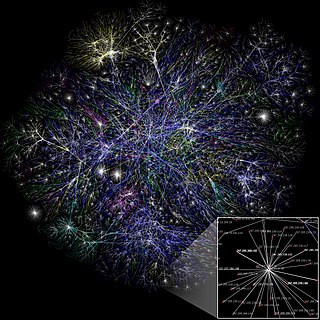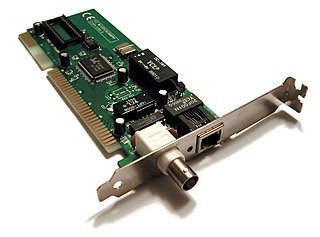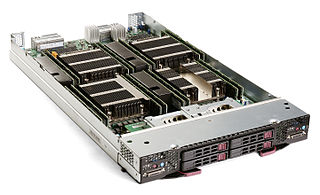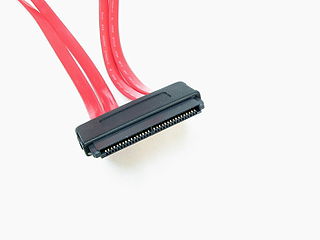External links
Ethernet family of local area network technologies | |
|---|---|
| Speeds | |
| General | |
| Organizations | |
| Media | |
| Historic | |
| Applications | |
| Transceivers | |
| Interfaces | |
| | This rail-transport related article is a stub. You can help Wikipedia by expanding it. |
Ethernet Consist Network (ECN) is a train communication network based on Ethernet technology standardised with IEC-61375-3-. This is a vehicle (consist) communication like Multifunction Vehicle Bus (MVB) in train communication network (TCN). [1]
ECN is organised in a ring topology to provide redundancy in the event of cable or component failure. It provides an Internet Protocol (IP) interface to TCMS (train control and management system) and other systems within a vehicle (consist). [2]
The Ethernet technology's large bandwidth (typically 100 Mbit/s) is particularly suitable for data-intensive systems like video surveillance or passenger information systems. [3]

Network topology is the arrangement of the elements of a communication network. Network topology can be used to define or describe the arrangement of various types of telecommunication networks, including command and control radio networks, industrial fieldbusses and computer networks.

An intelligent transportation system (ITS) is an advanced application which aims to provide innovative services relating to different modes of transport and traffic management and enable users to be better informed and make safer, more coordinated, and 'smarter' use of transport networks.

A network interface controller is a computer hardware component that connects a computer to a computer network.

Electronic test equipment is used to create signals and capture responses from electronic devices under test (DUTs). In this way, the proper operation of the DUT can be proven or faults in the device can be traced. Use of electronic test equipment is essential to any serious work on electronics systems.

An electronic control unit (ECU), also known as an electronic control module (ECM), is an embedded system in automotive electronics that controls one or more of the electrical systems or subsystems in a vehicle.

A blade server is a stripped-down server computer with a modular design optimized to minimize the use of physical space and energy. Blade servers have many components removed to save space, minimize power consumption and other considerations, while still having all the functional components to be considered a computer. Unlike a rack-mount server, a blade server fits inside a blade enclosure, which can hold multiple blade servers, providing services such as power, cooling, networking, various interconnects and management. Together, blades and the blade enclosure form a blade system, which may itself be rack-mounted. Different blade providers have differing principles regarding what to include in the blade itself, and in the blade system as a whole.
In automotive engineering, a vehicle bus is a specialized internal communications network that interconnects components inside a vehicle. Special requirements for vehicle control such as assurance of message delivery, of non-conflicting messages, of minimum time of delivery, of low cost, and of EMF noise resilience, as well as redundant routing and other characteristics mandate the use of less common networking protocols. Protocols include Controller Area Network (CAN), Local Interconnect Network (LIN) and others. Conventional computer networking technologies are rarely used, except in aircraft, where implementations of the ARINC 664 such as the Avionics Full-Duplex Switched Ethernet are used. Aircraft that use AFDX include the B787, the A400M and the A380. In train, implementations of Ethernet Consist Network (ECN) becomes most use, due to the grower of information. All cars sold in the United States since 1996 are required to have an On-Board Diagnostics connector, for access to the car's electronic controllers.

In computing, Serial Attached SCSI (SAS) is a point-to-point serial protocol that moves data to and from computer-storage devices such as hard disk drives and tape drives. SAS replaces the older Parallel SCSI bus technology that first appeared in the mid-1980s. SAS, like its predecessor, uses the standard SCSI command set. SAS offers optional compatibility with Serial ATA (SATA), versions 2 and later. This allows the connection of SATA drives to most SAS backplanes or controllers. The reverse, connecting SAS drives to SATA backplanes, is not possible.

A PHY, an abbreviation for "physical layer", is an electronic circuit, usually implemented as an integrated circuit, required to implement physical layer functions of the OSI model in a network interface controller.
Aeronautical Radio, Incorporated (ARINC), established in 1929, was a major provider of transport communications and systems engineering solutions for eight industries: aviation, airports, defense, government, healthcare, networks, security, and transportation. ARINC had installed computer data networks in police cars and railroad cars and also maintains the standards for line-replaceable units.
Fieldbus is the name of a family of industrial computer networks used for real-time distributed control. Fieldbus profiles are standardized by the International Electrotechnical Commission (IEC) as IEC 61784/61158.

Industrial Ethernet (IE) is the use of Ethernet in an industrial environment with protocols that provide determinism and real-time control. Protocols for industrial Ethernet include EtherCAT, EtherNet/IP, PROFINET, POWERLINK, SERCOS III, CC-Link IE, and Modbus TCP. Many industrial Ethernet protocols use a modified Media Access Control (MAC) layer to provide low latency and determinism. Some microcontrollers such as Sitara provide industrial Ethernet support.

Profinet is an industry technical standard for data communication over Industrial Ethernet, designed for collecting data from, and controlling equipment in industrial systems, with a particular strength in delivering data under tight time constraints. The standard is maintained and supported by Profibus & Profinet International, an umbrella organization headquartered in Karlsruhe, Germany.
The Time-Triggered Ethernet standard defines a fault-tolerant synchronization strategy for building and maintaining synchronized time in Ethernet networks, and outlines mechanisms required for synchronous time-triggered packet switching for critical integrated applications, IMA and integrated modular architectures. SAE International has released SAE AS6802 in November 2011.
Sercos III is the third generation of the Sercos interface, a standardized open digital interface for the communication between industrial controls, motion devices, input/output devices (I/O), and Ethernet nodes, such as PCs. Sercos III applies the hard real-time features of the Sercos interface to Ethernet. It is based upon and conforms to the Ethernet standard. Work began on Sercos III in 2003, with vendors releasing first products supporting it in 2005.

A storage area network (SAN) or storage network is a computer network which provides access to consolidated, block-level data storage. SANs are primarily used to access data storage devices, such as disk arrays and tape libraries from servers so that the devices appear to the operating system as direct-attached storage. A SAN typically is a dedicated network of storage devices not accessible through the local area network (LAN).
The train communication network (TCN) is a hierarchical combination of two fieldbus for data transmission within trains. It consists of the Multifunction Vehicle Bus (MVB) inside each vehicle and of the Wire Train Bus (WTB) to connect the different vehicles. The TCN components have been standardized in IEC 61375.
An Ethernet train backbone (ETB) is a train communication network based on Ethernet technology standardised with IEC-61375-2-5. This is a train-wide communication backbone such as Wire Train Bus (WTB).

UAVCAN is a lightweight protocol designed for reliable intra-vehicle communications using various communications transports, originally destined for CAN bus but targeting various network types in subsequent revisions.